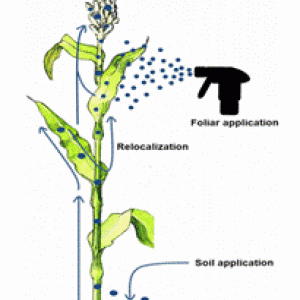
In this evidence review, co-written by FCRN member Ken Giller, the authors assess the extent to which agronomic fortification, the application of micronutrient fertiliser to crops, can improve the nutritional quality of diets in sub-Saharan Africa. They find that, while the technique has been shown to be effective in increasing the nutritional content and yield of crops, more research is required to establish the degree to which it can alleviate micronutrient deficiencies in humans.
The review paper appraises the potential impacts of agronomic fortification on nutritional quality and yield of crops, nutrition and human health status, and the environment. The technique’s specific applicability for implementation in sub-Saharan Africa is explored, as this is a region with severe and widespread soil fertility issues and high rates of micronutrient deficiencies in humans. In addition, it considers potential complementary approaches and alternatives within the specific physical and socio-economic conditions of the region.
The article focuses only on the micronutrients Zinc (Zn), Selenium (Se), and Iron (Fe) as these were considered most appropriate for the technique and important to human health. By analysing the bioavailability of micronutrients from soil, to crop, to food, and finally, to humans, the authors identified key factors that must be considered when attempting to understand whether agronomic fortification can be effective in alleviating micronutrient deficiency in humans (see Figure 1).

Figure 1: Schematic overview of micronutrient (MN) pathway. Based on Mayer et al. (2011).
While micronutrient deficiencies in humans are less immediately visible than energy deficiencies, they can lead to a range of severe health problems including sub-optimal metabolic functioning, susceptibility to infections, growth failure and cognitive impairment – which is also called hidden hunger. By applying micronutrient fertiliser to crops, it is hoped that more micronutrients are available for consumption and uptake by human populations, which would, in turn, reduce health concerns.
The authors highlight the need to consider nuanced approaches to micronutrient fertilisation given the diverse range of soils and conditions present in sub-Saharan Africa. These include different application techniques (leaf/soil application), combinations with Nitrogen-Phosphorus-Potassium (NPK) fertilisation and Integrated Soil Fertility Management (ISFM).
The effectiveness of agronomic biofortification on improving crops has been observed to vary a great deal depending on which micronutrient is applied:
- Zn – increases nutritional content and yields
- Se – increases nutritional content only
- Fe – slightly increases nutritional content under specific conditions
However, there is very little evidence demonstrating direct links between agronomic biofortification and human health. The authors stress that this knowledge gap prevents more definite conclusions being drawn. To bridge this gap, localised pilot-studies and experiments could be established.
There are a range of alternative techniques that are potentially more effective than agronomic biofortification. Some believe that genetic biofortification (breeding more nutritious varieties of crop) would be be more sustainable, especially in low income countries where fertilisers are not accessible or affordable. It is also widely argued that supplementation and dietary diversification may be more effective alternatives, especially in centralised urban areas. In fact, some see fortification approaches as a distraction from the key priority, which is dietary diversity and the development of a food system that improves access to a wider range of nutritious foods.
It remains unclear exactly what role agronomic fortification will have in eradicating micronutrient deficiencies in sub-Saharan Africa. Various steps need to be taken before it is economically or technically viable.
Abstract
Micronutrient deficiencies or ‘hidden hunger’ resulting from unbalanced diets based on starchy staple crops are prevalent among the population of sub-Saharan Africa. This review discusses the effectiveness of agronomic biofortification - the application of mineral micronutrient fertilisers to soils or plant leaves to increase micronutrient contents in edible parts of crops – and it's potential to fight hidden hunger. There is evidence that agronomic biofortification can increase yields and the nutritional quality of staple crops, but there is a lack of direct evidence that this leads to improved human health. Micronutrient fertilisation is most effective in combination with NPK, organic fertilizers and improved crop varieties, highlighting the importance of integrated soil fertility management. Agronomic biofortification provides an immediate and effective route to enhancing micronutrient concentrations in edible crop products, although genetic biofortification may be more cost effective in the long run.
Reference
de Valença, A.W., Bake, A., Brouwer, I.D. and Giller, K.E., 2017. Agronomic biofortification of crops to fight hidden hunger in sub-Saharan Africa. Global Food Security, 12, pp.8-14.
Read the full article here (open access).







Post a new comment »